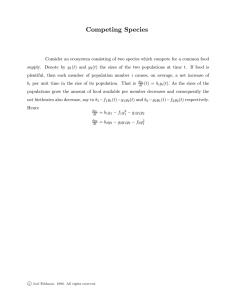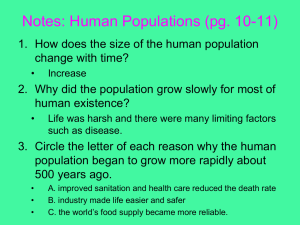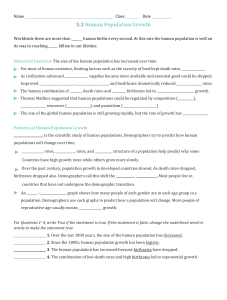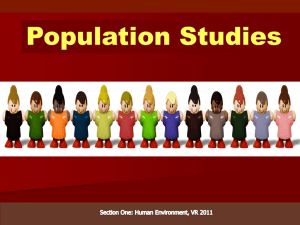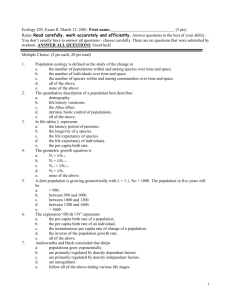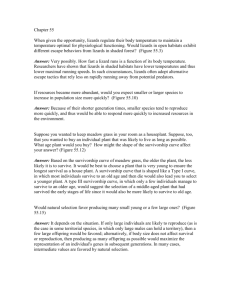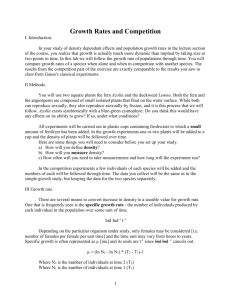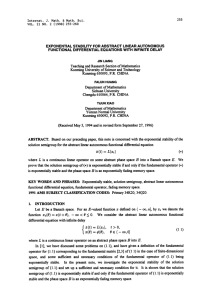Human Population and Demographics
advertisement
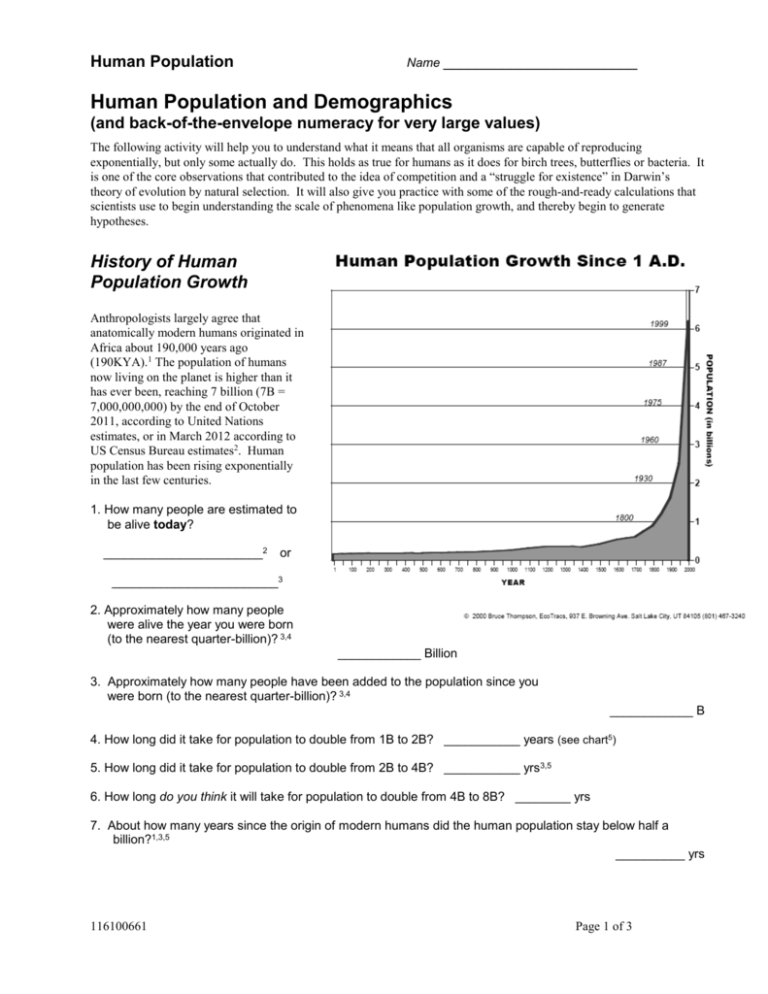
Human Population Name _______________________ Human Population and Demographics (and back-of-the-envelope numeracy for very large values) The following activity will help you to understand what it means that all organisms are capable of reproducing exponentially, but only some actually do. This holds as true for humans as it does for birch trees, butterflies or bacteria. It is one of the core observations that contributed to the idea of competition and a “struggle for existence” in Darwin’s theory of evolution by natural selection. It will also give you practice with some of the rough-and-ready calculations that scientists use to begin understanding the scale of phenomena like population growth, and thereby begin to generate hypotheses. History of Human Population Growth Anthropologists largely agree that anatomically modern humans originated in Africa about 190,000 years ago (190KYA).1 The population of humans now living on the planet is higher than it has ever been, reaching 7 billion (7B = 7,000,000,000) by the end of October 2011, according to United Nations estimates, or in March 2012 according to US Census Bureau estimates2. Human population has been rising exponentially in the last few centuries. 1. How many people are estimated to be alive today? _______________________2 or ________________________3 2. Approximately how many people were alive the year you were born (to the nearest quarter-billion)? 3,4 ____________ Billion 3. Approximately how many people have been added to the population since you were born (to the nearest quarter-billion)? 3,4 ____________ B 4. How long did it take for population to double from 1B to 2B? ___________ years (see chart5) 5. How long did it take for population to double from 2B to 4B? ___________ yrs3,5 6. How long do you think it will take for population to double from 4B to 8B? ________ yrs 7. About how many years since the origin of modern humans did the human population stay below half a billion?1,3,5 __________ yrs 116100661 Page 1 of 3 Human Population Name _______________________ How big is 7,000,000,000? If everyone living were able to stand/sit in a line and hold hands, how long would the line be? We’ll do some rough calculations to approximate this length and get an idea of what 7 billion people means. Have ten students stand and comfortably hold hands in a line. Measure the length of this line. 8. What is the average length per person in the line? ______________ meters 9. If that is the average for humans, what is the expected length of a line of 7B? ______________ meters ÷ 1000 = ____________ km X 0.62 = _____________ miles For comparison, the equatorial diameter of the Earth is 12,756km (7,926 miles). The moon is, on average, about 385,000 km (236,259 mi.) from Earth. 10. About 2B of the people on the planet today are under 15 years old.6 Assume that their average reach is half that of the people in this class. We will use this to calculate a reduction in the length of our 7B person line: a) What is the estimated length of this line of 2B pre-15year olds? _____________ km b) What is the estimated length the remaining line of 5B adults? ______________ km c) What is the total estimated line length for 5B adults plus 2B pre-15year olds? _____________ km How do we estimate population? Population is estimated based on a standard systems model of a stock with an inflow and an outflow: Births Living population Deaths Population increases when the number of births exceeds the number of deaths in a given timeframe. The rate at which population is increasing has been slowing, since a peak annual growth rate of 2.2% in 1963; for 2011, it was only 1.2%.7 Average lifespan is increasing, but birthrates are slowing a little faster. Global Population Change List five countries that you think have rapidly increasing populations: 1 2 3 4 5 116100661 List five countries that you think have stable or declining populations: 1 2 3 4 5 Page 2 of 3 Human Population Name _______________________ Large countries with increasing populations: 4,8,9 Large countries with stable or declining populations: 4,8,9 1 1 2 2 3 3 4 4 5 5 11. Why did you choose the ones you chose initially? How did your ideas compare to the actual statistics?4,8,9 Watch the video - http://www.gapminder.org/videos/population-growth-explained-with-ikea-boxes - discuss the following, and note your responses below (or use the back of the sheet): 12. What factors do you think are probably contributing to increasing lifespans globally? 13. What factors do you think are probably contributing to decreasing birthrates globally? 14. How does this relate to which countries are increasing in population compared to stabilized countries? References: 1. 2. 3. 4. 5. 6. 7. 8. 9. Boyd & Silk, 2012, How Humans Evolved (6th Ed.) http://www.census.gov/population/popclockworld.html (3/29/12) http://galen.metapath.org/popclk.html http://www.earth-policy.org/books/fpep/fpep_data#3 (11/7/12) Thompson, 2000, EcoTracs http://www.wolframalpha.com/input/?i=population+under+15 (11/7/12) “The World of 7 Billion” Wall Chart http://www.worldof7billion.org/wall_chart (10/24/11) http://www.wolframalpha.com (11/7/12) http://www.prb.org/pdf12/2012-population-data-sheet_eng.pdf (11/7/12) 116100661 Page 3 of 3
